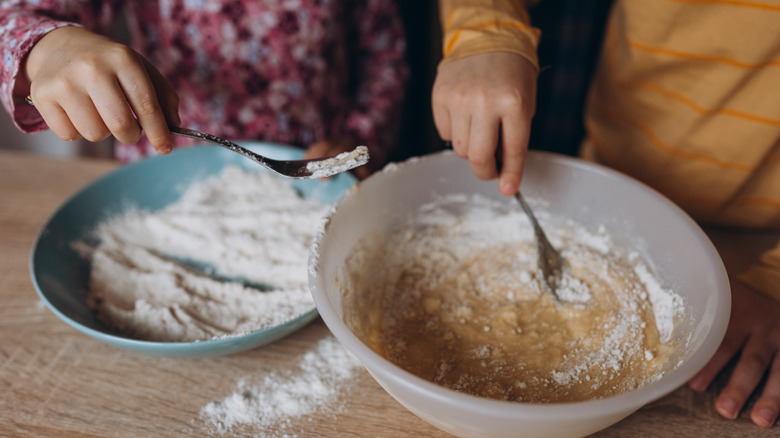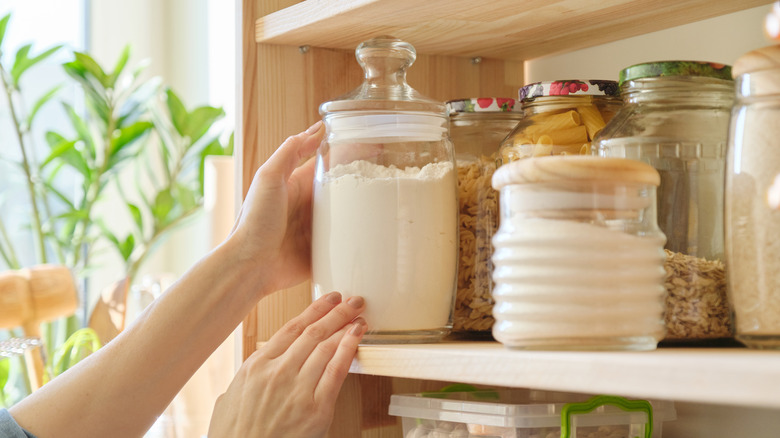Turn All-Purpose Flour Into Self-Rising Flour With 2 Staple Ingredients
If you're a regular at making cakes, scones, and biscuits, you know that self-rising flour is a common ingredient in the world of baking. However, you don't actually need to fill up precious pantry space by stocking up on it. That's because it's really easy to make it at home using other ingredients you probably already have: all-purpose flour, baking powder, and salt.
For the unfamiliar, self-rising flour is basically regular flour that comes pre-combined with a leavening agent and salt. That's why recipes that call for it don't have a those extras on the ingredient list. The exact leavening agent found in self-rising flour is baking powder, and its function is to make the dough or batter expand by releasing gas upon coming in contact with water or heat. On the other hand, salt works to enhance the flavor of the flour and the other ingredients in your baked goods.
To DIY it at home, start by putting 1 cup of regular flour, 1 ½ teaspoons of baking powder, and ¼ teaspoon of salt in a bowl. Whisk thoroughly to create a homogenous mixture. If you don't have baking powder on hand, you can start by making it by using baking soda and an acid in a ratio of 1 part baking soda to 2 parts of acid (usually cream of tartar). You can also add 1 part of cornstarch to serve as a stabilizer.
How to use your homemade self-rising flour
Your homemade self-rising flour basically serves the same function as the store-bought one, therefore, you can use it as a substitute in any recipe where the self-rising flour is required. Such recipes include cakes, muffins, cookies, biscuits, waffles, cornbread, quick breads, and pancakes. Another scenario where your homemade self-rising flour can come in handy is if the recipe calls for regular flour and a leavener and you lack either of these ingredients. In that case, if you already have some leftover self-rising flour, you can use it in place of the regular flour and baking powder. However, pay attention to the amount of baking powder required per cup of all-purpose flour, if it's more than what you used to make your self-rising flour, you'll need to add some more to balance out the difference. It's important to note that self-rising flour can only be used as a substitute in recipes with baking powder and not a biological leavener like yeast.
One difference to keep in mind when using homemade self-rising flour in place of the store-bought version is that the store-bought variety is made using soft wheat, which has fewer proteins than the all-purpose flour you use in homemade self-rising flour. As a result, if you're used to buying your self-rising flour, when you switch to homemade, the baked goods won't be as tender. Luckily, the difference is subtle and most people won't even notice.
How to store your homemade self-rising flour
If you make a big batch of homemade self-rising flour that can't be used up in one sitting, it's okay to store the remaining amount for later use. Storing self-rising flour requires extra caution to avoid premature activation of the leavener or spoilage of the flour, which often happens when the oils in the flour turn rancid.
First, put the flour in an air-tight container, as exposure to oxygen can cause oxidation and lead to spoilage of the flour. Secondly, place the container in a cool, dark place away from any direct heat source. Exposing wheat flour to heat is one of the storage mistakes that can cause spoilage through rancidity. The storage spot and container should also be kept dry since any moisture or humidity coming in contact with the baking powder component in the self-rising flour will result in premature activation of the leavening agent, and it won't function as required when used in a recipe.
With these key factors in mind, the best place to store your self-rising flour once packed in an air-tight container is in the pantry. Use the flour within about six months because that's how long the wheat flour and the baking powder in the self-rising flour can last at room temperature after being opened. Even with proper storage, the leavening agent will deteriorate with time, so the sooner you use the flour the better.


